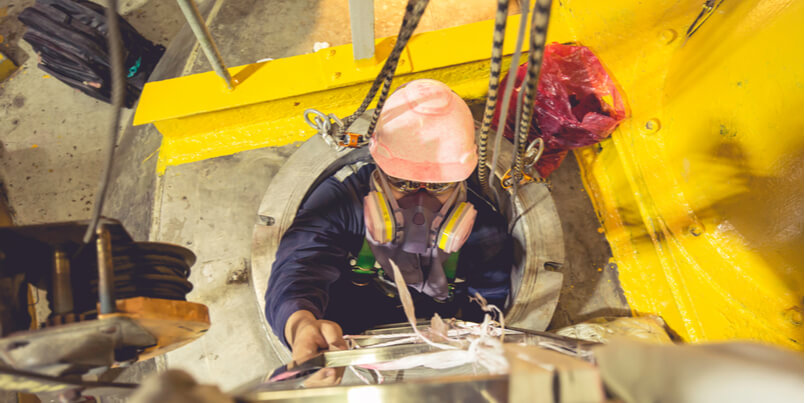 According to statistics released by the US Bureau of Labor, more than 2 million workers enter a permit required confined space environment every year for the purposes of routine maintenance, repairs, or inspections.
According to statistics released by the US Bureau of Labor, more than 2 million workers enter a permit required confined space environment every year for the purposes of routine maintenance, repairs, or inspections.
The presence of harmful gases or vapours within these environments can pose a significant threat to worker safety, with confined space entries having been documented as one of the leading causes of fatalities in the workplace.
In the period between 2011 and 2018, a total of 1030 workers were reported as having died as the result of occupational injuries that occured within a confined space - ranging from a low of 88 deaths in 2012 to a high of 166 in 2017.
In just over half of all cases of worker fatality in confined spaces, it is exposure to some form of atmospheric hazard that is the leading cause of death - with the two most common culprits being hydrogen sulfide and carbon monoxide.
Reality checking plans, processes and equipment
Writing in Occupational Health and Safety (OHS) Online, Missouri Fire Department Captain and Emergency Response Consultant, Chris Koester, explains what he believes are the root causes of incidents of serious injury or death during the course of confined space entry work.
Koester highlights shortfalls in the quality of confined space entry and rescue training - and a lack of understanding of the most common hazards that can be encountered within these environments.
He also points to multiple instances of insufficient or incorrect equipment, poorly maintained equipment - and in some cases, a lack of any equipment at all.
The statistics paint an alarming picture.
Of 100 incidents that were investigated in 2018, just 31% of facilities had some form of written confined space entry procedure - but none had put these written procedures into practice during the incident in question.
And while 15% of personnel had received confined space training, none of the facilities had any type of formal rescue plan in place.
In order to improve the statistics on confined space injuries and fatalities, Koester believes it is vital that every business carries out a "reality check" of its processes, its emergency procedures and its inventory of equipment.
The first task, he says, is to create a well-designed rescue plan that can be properly and realistically executed.
It is also important to thoroughly scrutinise the permit required confined space procedures that are currently in place, and to assign and correctly train workers and rescuers.
Thirdly, there is the also need to regularly inventory all equipment and to repair or replace as necessary.
Assessing the risk of the confined space environment
Understandably of course, not all confined space environments present the same level of threat.
In areas that are defined as Low Risk, for example, there will be an easy entry and exit route, with some natural ventilation and no requirement for the use of Emergency Escape Breathing Apparatus or the donning of escape equipment.
In Medium Risk confined spaces there is a higher expectation of encountering one or more specified risks. The time needed to exit a Medium Risk area is also typically greater, whether due to the distance travelled from the point of entry or the fact that more than one worker is operating within the same environment.
Escape breathing apparatus will need to be used and one or more workers stationed outside the area to control access and handle any problems that may arise.
High Risk confined spaces will be ones where there is a known hazard that either cannot be controlled or that cannot be eliminated, but where work must be carried out regardless of that risk.
Personnel will need to don full working breathing apparatus and be supported by additional personnel who are responsible for overseeing safe entry and exit.
Realistic training for confined space entry
One of the vital tools of the trade for confined space workers is a portable multi-gas meter which is used to provide an instant audio or visual indication of the presence of a harmful gas or vapor.
For the most part, these meters will monitor a handful of the most common gases, with the most common being oxygen, carbon monoxide, hydrogen sulfide and lower explosive limit (LEL).
Until recently, the ability to accurately simulate the environmental conditions of multi-gas incidents in training scenarios has been limited at best.
There has also been the urgent need for a training device that can simulate and demonstrate the causes and the conditions of oxygen depletion.
The safety and accuracy of gas detection has now been substantially enhanced by the release of the multi-gas simulation tools, the MultiGAS-SIM, which enables personnel to safely train for the operational challenges of confined space environments.
For those personnel tasked with operating within confined space environments, whether as routine workers or in the role of rescuer, safety will always be key.
What is crucial is that they understand not only the potentially hazardous nature of the environment that they are about to enter but that they are confident in the use of the detector equipment that is there to protect them.
With the addition of powerful and realistic multi-gas simulator training technology, such as the MultiGAS-SIM, confined space workers now have the opportunity to train for the unique challenges of their role in a safe and controlled environment - and to substantially enhance their safety in the workplace.







